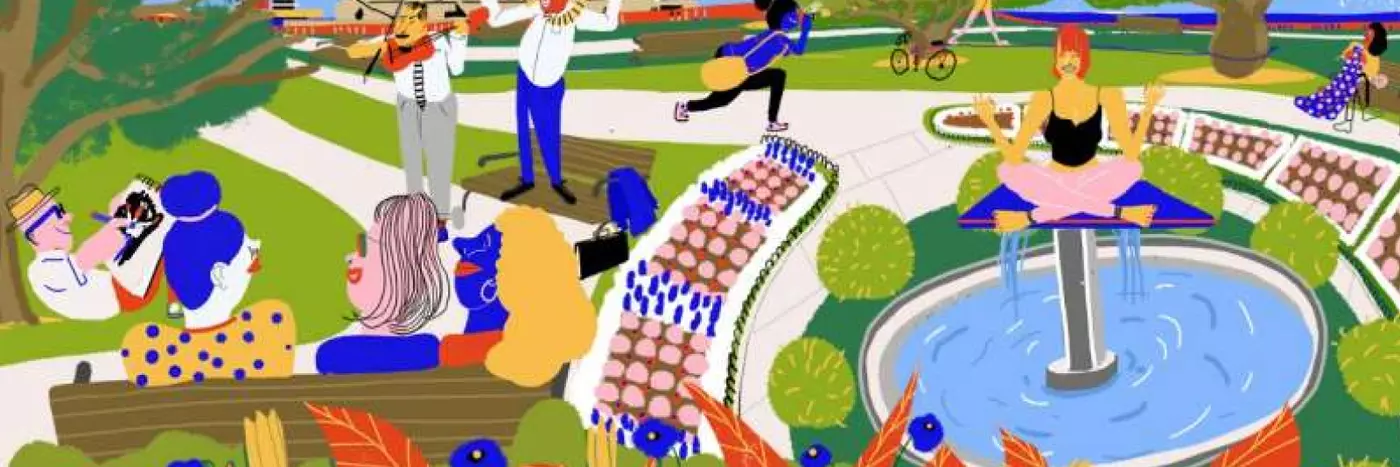The case for everyday creativity
Meditation teacher and academic Dr Nadine Cameron writes on casting aside the “fear of the quality of output” and finding fulfilment in everyday acts of art and imagination.
Our new annual program of workshops, experiences and performances in the Centre for Creativity is an invitation to experience the joy and flow of creative practices, and to get up close to the innate creativity inside every one of us. You may rediscover the dancer within, the keen eye you have for design or art-making, or connect emotionally through the power of song or performance up close. We need this now, more than ever, and for our collective futures and wellbeing.
- Tamara Harrison, Head of Children, Families and Creative Learning.
In the film Paterson, by Jim Jarmusch, the titular character is a suburban bus driver who, though living an unremarkable life, finds inspiration at every turn. His engagement with poetry – reading it and writing it – helps him see his entire world through a lyrical lens; the simplest of moments and objects take on for him an almost translucent wonder. Such creative engagement with life is available to all of us. We just have to learn to see creativity and its possibilities differently.
The last decade has seen some notable shifts in how we create. Advances in technology and content sharing have gifted millions of people opportunities both to make with media once prohibitively expensive to them and show their films, photography and music across the globe. At the same time, the creeping sense that we lost something important in eschewing the organic and handmade for the mass-produced has sparked a resurgence of interest in crafts. Folk, in surprising numbers, are taking up needlepoint, woodturning, the ceramic arts and other old world-y pursuits.
More of us than ever before wading into acts of making has done little, however, to discourage the unhelpful distinction, long been made in our society, between the 'true' artists and the rest of us who, in our creative endeavours, are faking it, or merely muddling through. We all know who the ‘real’ artists are: those with the imprimatur of institutions – galleries, publishers, music press, and the like – with certain cultural cachet or commercial clout. The ruthless ranking done by the cognoscenti, together with our society’s deeply competitive ethos, have the terrible combined effect of discouraging many people who might otherwise have had a go from simply playing. Creating for the sake of creating.
Just as unhelpful for the would-be creative are distinctions such as those between the so-called fine arts and other artforms – or, really, ways of being creative – and, say, art versus craft. The latter posits art as employing superior faculties such as originality and deep emotional expression, where craft is about the repetitive application of a narrow skillset. These kinds of notions encourage us to believe that only some people are creative or, perhaps even worse, deserve to be creative. It also leads many of us to dismiss things we already do, or that are already within our skill set to do, as acts of creation.
What happens when you cast aside the distinction between high art and low art? When you go further and throw out limiting beliefs about what it is to be creative altogether? Life is vastly richer when we are brave enough to make art without fear of the quality of output. In fact, that state of beginnerhood – of being at the very start of learning a new art form – can deliver immeasurable delights. Before our techniques become habit we can dwell in a state of delighted surprise at what our subconscious and hands can work in concert to produce. When we discover in what kinds of directions a medium can be pushed, we seem to expand our sense of what is possible more generally. We benefit just as much from playing with ideas themselves. We can engage with other people’s works of art in ways that push against the grain, or try out new ideas about ourselves, about our relationships, and about the objects around us in daring and original ways. Just as we can take a lump of clay and remould it, we can take limiting beliefs and turn them into something inspiring.
We have been right to celebrate the fact that Covid lockdowns have spurred many of us into being creative. What we haven’t done, however, is go far enough in identifying which acts might be considered creative. Inventing recipes is great and taking up painting, wonderful. But just as exciting is that many of us have reconceptualised how to live and love within the spaces we’re confined to. Or that we’ve learned to adapt to our surroundings in new ways. Or come to see as beautiful or useful, a once overlooked nook in our home or once disdained colander. Or come to value life itself differently. Creativity in our thinking is every bit as life-enhancing as any other form of creativity. And it is available to everyone.
A range of events I have run – meditations and emotionally responsive tours in galleries, sensory events, meditations that blend literature with the evocation of memories – have been designed to encourage new imagining and thus experiences of life. I have seen firsthand that humans are brilliant at reappraising the familiar, at finding fresh perspectives on things, and how that can give them new hope or zest for life. You just need to be open, as Paterson was, to believing that imagination is a gift and, with it, you can create the world you want.
Announcing the Centre for Creativity

